Leadership Styles and Motivation: Thomas Cook Case Study Report
VerifiedAdded on 2023/01/11
|11
|3833
|86
Report
AI Summary
This report presents a case study analysis of Thomas Cook, a UK-based travel and tourism company, examining its leadership and management practices. The report explores the functions and principles of management, including planning, organizing, staffing, directing, and controlling, as well as the importance of coordination and cooperation. It delves into various leadership styles such as democratic, situational, and transformational, highlighting their impact on employee motivation and performance. The report also analyzes the effects of power, influence, and conflict within the organization, including the role of rewards, legitimate authority, expertise, and referent power. Furthermore, it discusses different types of motivation, including positive and negative approaches, and explores the application of Maslow's hierarchy of needs. The report concludes with recommendations and a summary of the findings, providing a comprehensive overview of leadership and management strategies at Thomas Cook. The assignment is based on a case study of Thomas Cook, and also explains steps to achieve higher performance and its impact on employees.
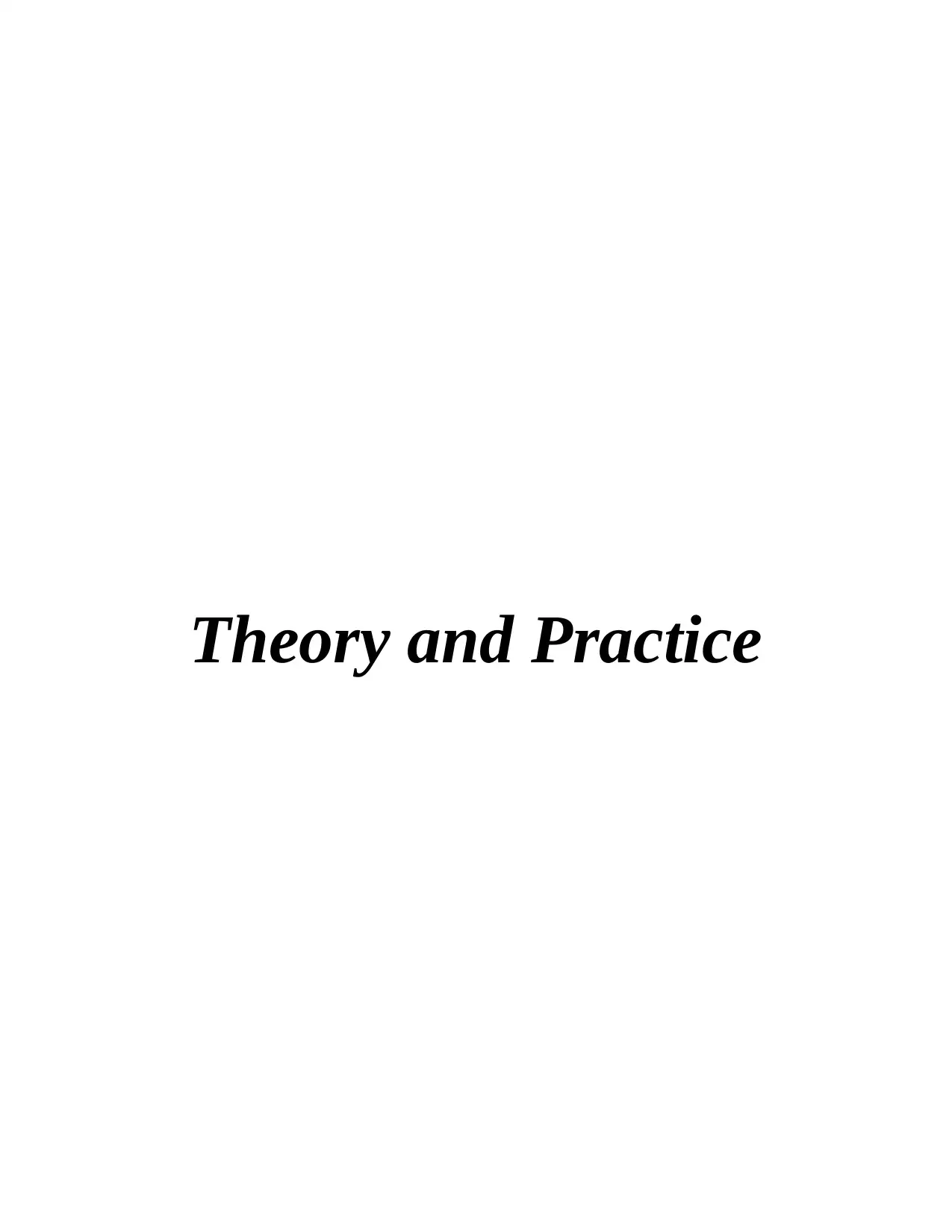
Theory and Practice
Paraphrase This Document
Need a fresh take? Get an instant paraphrase of this document with our AI Paraphraser
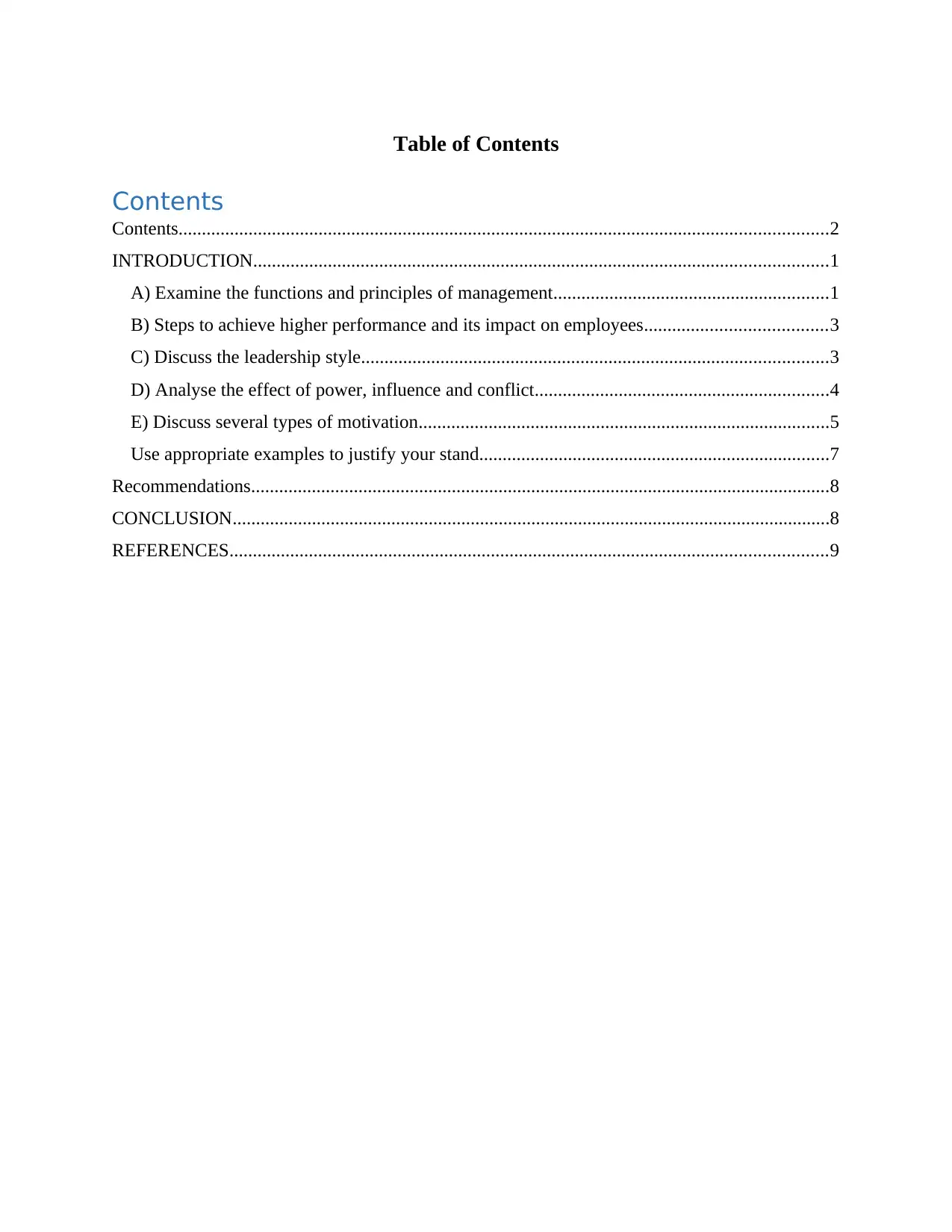
Table of Contents
Contents
Contents...........................................................................................................................................2
INTRODUCTION...........................................................................................................................1
A) Examine the functions and principles of management...........................................................1
B) Steps to achieve higher performance and its impact on employees.......................................3
C) Discuss the leadership style....................................................................................................3
D) Analyse the effect of power, influence and conflict...............................................................4
E) Discuss several types of motivation........................................................................................5
Use appropriate examples to justify your stand...........................................................................7
Recommendations............................................................................................................................8
CONCLUSION................................................................................................................................8
REFERENCES................................................................................................................................9
Contents
Contents...........................................................................................................................................2
INTRODUCTION...........................................................................................................................1
A) Examine the functions and principles of management...........................................................1
B) Steps to achieve higher performance and its impact on employees.......................................3
C) Discuss the leadership style....................................................................................................3
D) Analyse the effect of power, influence and conflict...............................................................4
E) Discuss several types of motivation........................................................................................5
Use appropriate examples to justify your stand...........................................................................7
Recommendations............................................................................................................................8
CONCLUSION................................................................................................................................8
REFERENCES................................................................................................................................9
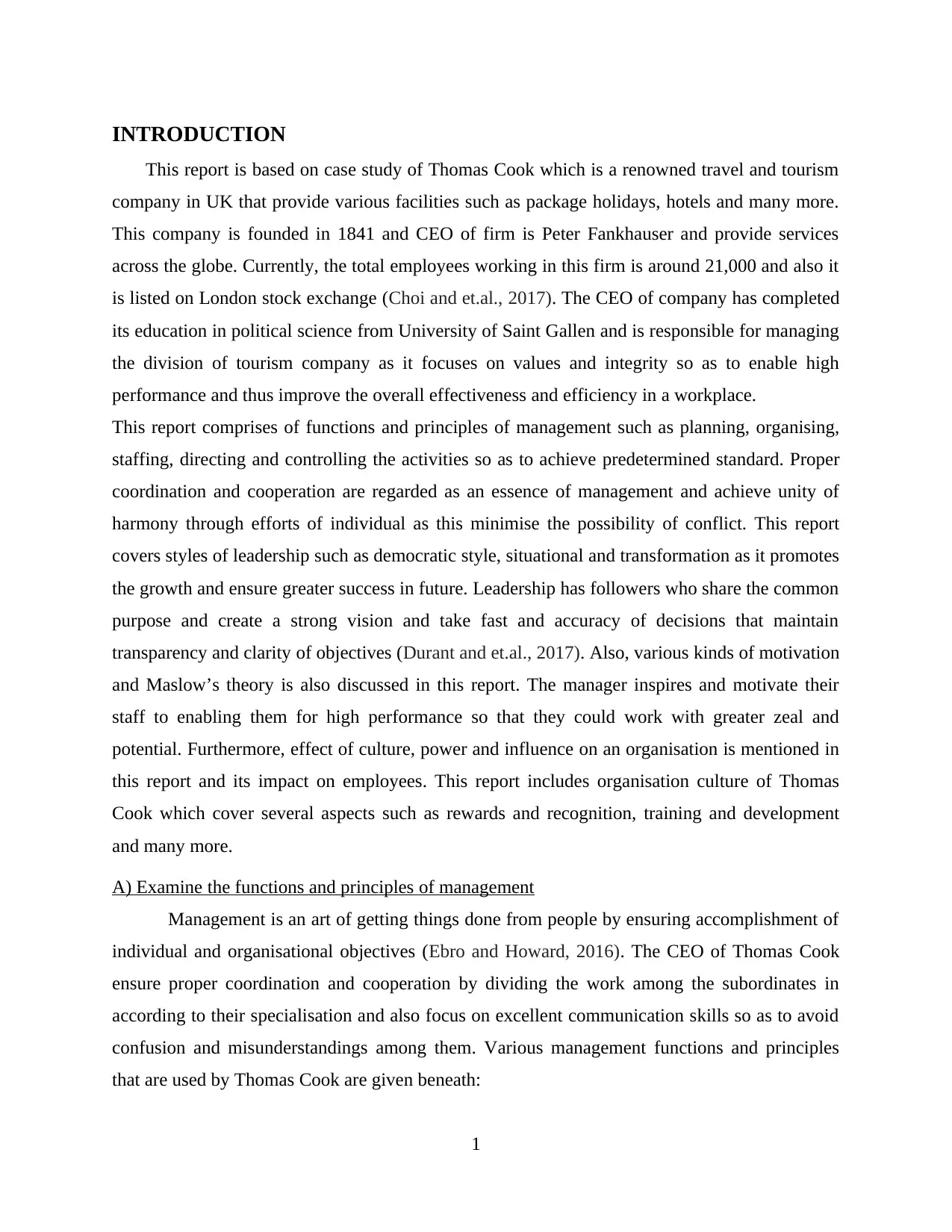
INTRODUCTION
This report is based on case study of Thomas Cook which is a renowned travel and tourism
company in UK that provide various facilities such as package holidays, hotels and many more.
This company is founded in 1841 and CEO of firm is Peter Fankhauser and provide services
across the globe. Currently, the total employees working in this firm is around 21,000 and also it
is listed on London stock exchange (Choi and et.al., 2017). The CEO of company has completed
its education in political science from University of Saint Gallen and is responsible for managing
the division of tourism company as it focuses on values and integrity so as to enable high
performance and thus improve the overall effectiveness and efficiency in a workplace.
This report comprises of functions and principles of management such as planning, organising,
staffing, directing and controlling the activities so as to achieve predetermined standard. Proper
coordination and cooperation are regarded as an essence of management and achieve unity of
harmony through efforts of individual as this minimise the possibility of conflict. This report
covers styles of leadership such as democratic style, situational and transformation as it promotes
the growth and ensure greater success in future. Leadership has followers who share the common
purpose and create a strong vision and take fast and accuracy of decisions that maintain
transparency and clarity of objectives (Durant and et.al., 2017). Also, various kinds of motivation
and Maslow’s theory is also discussed in this report. The manager inspires and motivate their
staff to enabling them for high performance so that they could work with greater zeal and
potential. Furthermore, effect of culture, power and influence on an organisation is mentioned in
this report and its impact on employees. This report includes organisation culture of Thomas
Cook which cover several aspects such as rewards and recognition, training and development
and many more.
A) Examine the functions and principles of management
Management is an art of getting things done from people by ensuring accomplishment of
individual and organisational objectives (Ebro and Howard, 2016). The CEO of Thomas Cook
ensure proper coordination and cooperation by dividing the work among the subordinates in
according to their specialisation and also focus on excellent communication skills so as to avoid
confusion and misunderstandings among them. Various management functions and principles
that are used by Thomas Cook are given beneath:
1
This report is based on case study of Thomas Cook which is a renowned travel and tourism
company in UK that provide various facilities such as package holidays, hotels and many more.
This company is founded in 1841 and CEO of firm is Peter Fankhauser and provide services
across the globe. Currently, the total employees working in this firm is around 21,000 and also it
is listed on London stock exchange (Choi and et.al., 2017). The CEO of company has completed
its education in political science from University of Saint Gallen and is responsible for managing
the division of tourism company as it focuses on values and integrity so as to enable high
performance and thus improve the overall effectiveness and efficiency in a workplace.
This report comprises of functions and principles of management such as planning, organising,
staffing, directing and controlling the activities so as to achieve predetermined standard. Proper
coordination and cooperation are regarded as an essence of management and achieve unity of
harmony through efforts of individual as this minimise the possibility of conflict. This report
covers styles of leadership such as democratic style, situational and transformation as it promotes
the growth and ensure greater success in future. Leadership has followers who share the common
purpose and create a strong vision and take fast and accuracy of decisions that maintain
transparency and clarity of objectives (Durant and et.al., 2017). Also, various kinds of motivation
and Maslow’s theory is also discussed in this report. The manager inspires and motivate their
staff to enabling them for high performance so that they could work with greater zeal and
potential. Furthermore, effect of culture, power and influence on an organisation is mentioned in
this report and its impact on employees. This report includes organisation culture of Thomas
Cook which cover several aspects such as rewards and recognition, training and development
and many more.
A) Examine the functions and principles of management
Management is an art of getting things done from people by ensuring accomplishment of
individual and organisational objectives (Ebro and Howard, 2016). The CEO of Thomas Cook
ensure proper coordination and cooperation by dividing the work among the subordinates in
according to their specialisation and also focus on excellent communication skills so as to avoid
confusion and misunderstandings among them. Various management functions and principles
that are used by Thomas Cook are given beneath:
1
⊘ This is a preview!⊘
Do you want full access?
Subscribe today to unlock all pages.

Trusted by 1+ million students worldwide
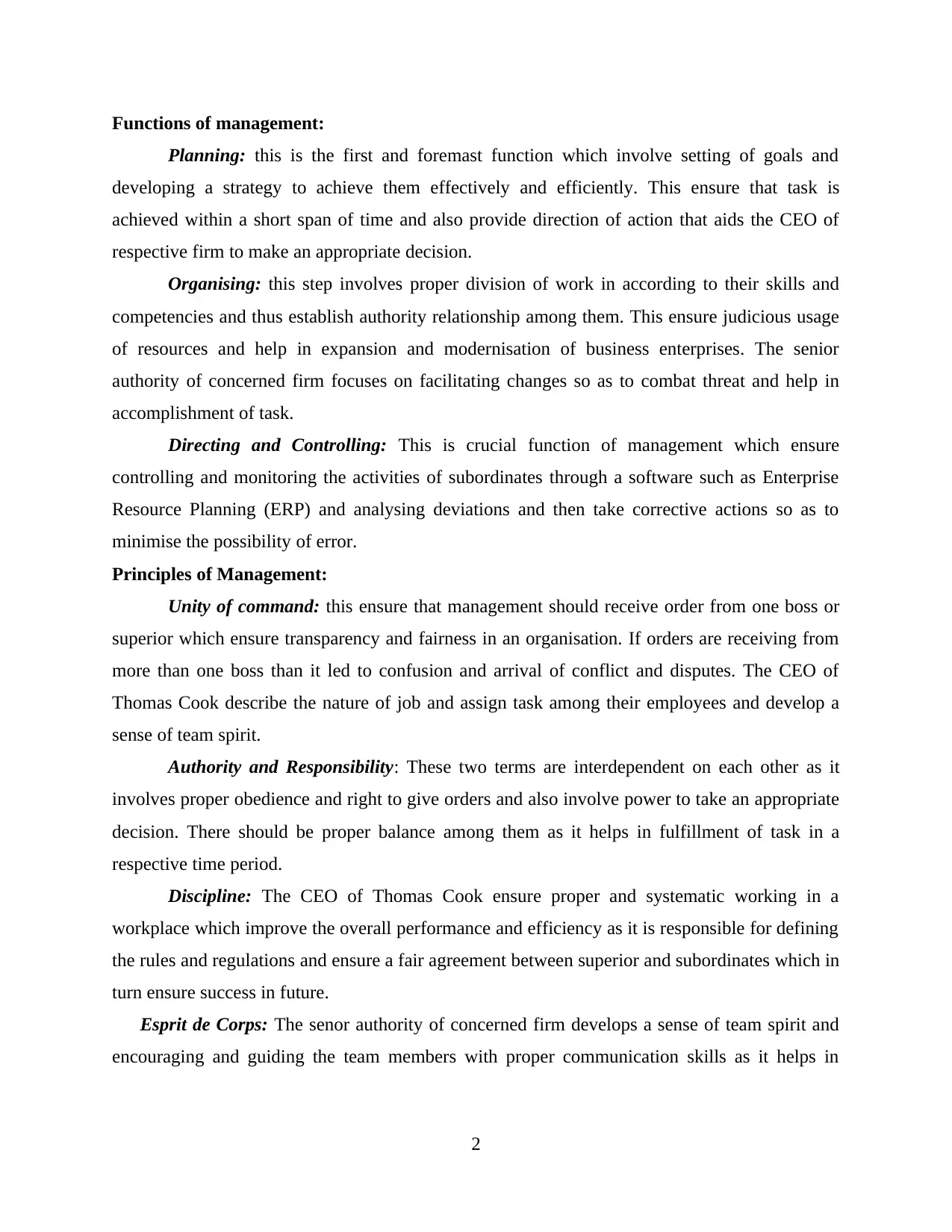
Functions of management:
Planning: this is the first and foremast function which involve setting of goals and
developing a strategy to achieve them effectively and efficiently. This ensure that task is
achieved within a short span of time and also provide direction of action that aids the CEO of
respective firm to make an appropriate decision.
Organising: this step involves proper division of work in according to their skills and
competencies and thus establish authority relationship among them. This ensure judicious usage
of resources and help in expansion and modernisation of business enterprises. The senior
authority of concerned firm focuses on facilitating changes so as to combat threat and help in
accomplishment of task.
Directing and Controlling: This is crucial function of management which ensure
controlling and monitoring the activities of subordinates through a software such as Enterprise
Resource Planning (ERP) and analysing deviations and then take corrective actions so as to
minimise the possibility of error.
Principles of Management:
Unity of command: this ensure that management should receive order from one boss or
superior which ensure transparency and fairness in an organisation. If orders are receiving from
more than one boss than it led to confusion and arrival of conflict and disputes. The CEO of
Thomas Cook describe the nature of job and assign task among their employees and develop a
sense of team spirit.
Authority and Responsibility: These two terms are interdependent on each other as it
involves proper obedience and right to give orders and also involve power to take an appropriate
decision. There should be proper balance among them as it helps in fulfillment of task in a
respective time period.
Discipline: The CEO of Thomas Cook ensure proper and systematic working in a
workplace which improve the overall performance and efficiency as it is responsible for defining
the rules and regulations and ensure a fair agreement between superior and subordinates which in
turn ensure success in future.
Esprit de Corps: The senor authority of concerned firm develops a sense of team spirit and
encouraging and guiding the team members with proper communication skills as it helps in
2
Planning: this is the first and foremast function which involve setting of goals and
developing a strategy to achieve them effectively and efficiently. This ensure that task is
achieved within a short span of time and also provide direction of action that aids the CEO of
respective firm to make an appropriate decision.
Organising: this step involves proper division of work in according to their skills and
competencies and thus establish authority relationship among them. This ensure judicious usage
of resources and help in expansion and modernisation of business enterprises. The senior
authority of concerned firm focuses on facilitating changes so as to combat threat and help in
accomplishment of task.
Directing and Controlling: This is crucial function of management which ensure
controlling and monitoring the activities of subordinates through a software such as Enterprise
Resource Planning (ERP) and analysing deviations and then take corrective actions so as to
minimise the possibility of error.
Principles of Management:
Unity of command: this ensure that management should receive order from one boss or
superior which ensure transparency and fairness in an organisation. If orders are receiving from
more than one boss than it led to confusion and arrival of conflict and disputes. The CEO of
Thomas Cook describe the nature of job and assign task among their employees and develop a
sense of team spirit.
Authority and Responsibility: These two terms are interdependent on each other as it
involves proper obedience and right to give orders and also involve power to take an appropriate
decision. There should be proper balance among them as it helps in fulfillment of task in a
respective time period.
Discipline: The CEO of Thomas Cook ensure proper and systematic working in a
workplace which improve the overall performance and efficiency as it is responsible for defining
the rules and regulations and ensure a fair agreement between superior and subordinates which in
turn ensure success in future.
Esprit de Corps: The senor authority of concerned firm develops a sense of team spirit and
encouraging and guiding the team members with proper communication skills as it helps in
2
Paraphrase This Document
Need a fresh take? Get an instant paraphrase of this document with our AI Paraphraser
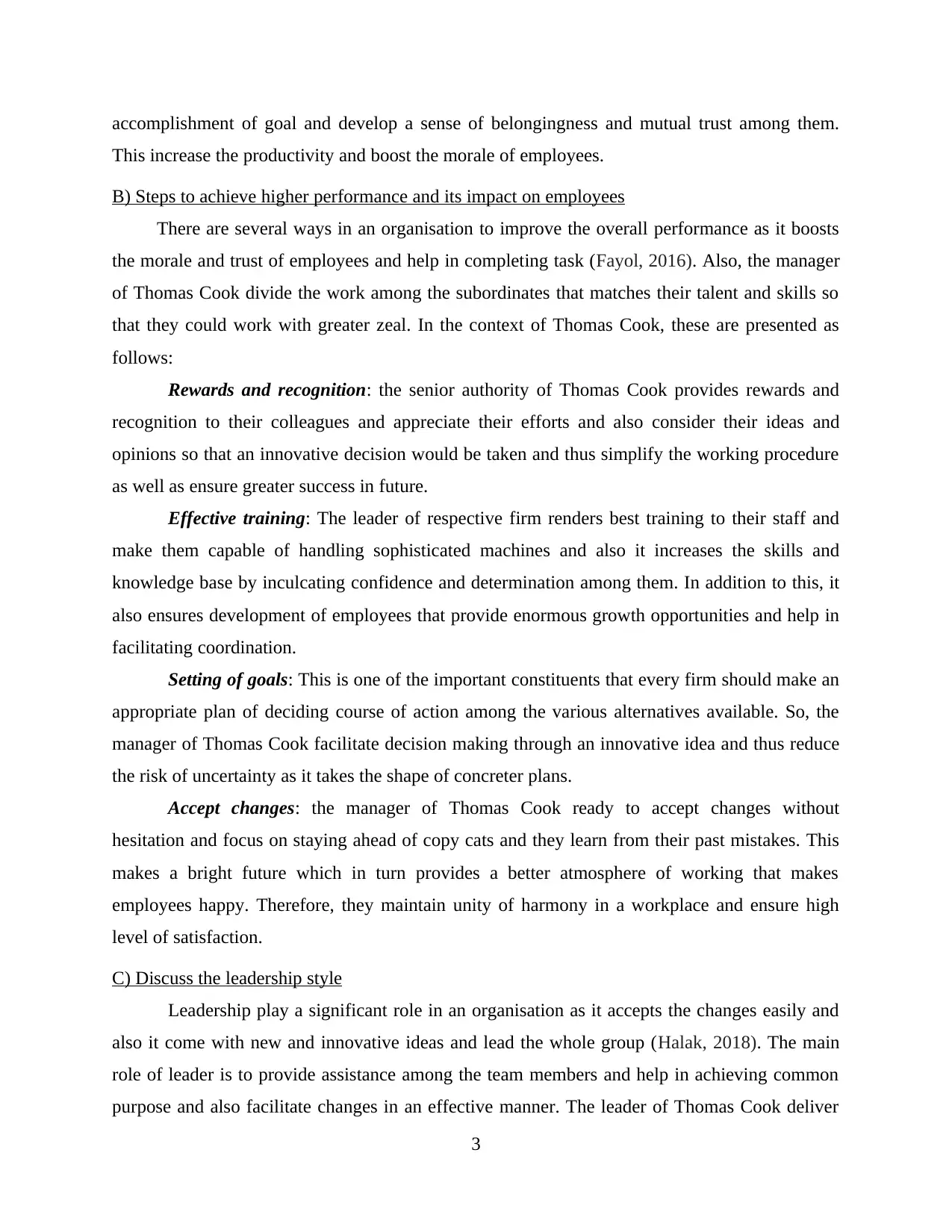
accomplishment of goal and develop a sense of belongingness and mutual trust among them.
This increase the productivity and boost the morale of employees.
B) Steps to achieve higher performance and its impact on employees
There are several ways in an organisation to improve the overall performance as it boosts
the morale and trust of employees and help in completing task (Fayol, 2016). Also, the manager
of Thomas Cook divide the work among the subordinates that matches their talent and skills so
that they could work with greater zeal. In the context of Thomas Cook, these are presented as
follows:
Rewards and recognition: the senior authority of Thomas Cook provides rewards and
recognition to their colleagues and appreciate their efforts and also consider their ideas and
opinions so that an innovative decision would be taken and thus simplify the working procedure
as well as ensure greater success in future.
Effective training: The leader of respective firm renders best training to their staff and
make them capable of handling sophisticated machines and also it increases the skills and
knowledge base by inculcating confidence and determination among them. In addition to this, it
also ensures development of employees that provide enormous growth opportunities and help in
facilitating coordination.
Setting of goals: This is one of the important constituents that every firm should make an
appropriate plan of deciding course of action among the various alternatives available. So, the
manager of Thomas Cook facilitate decision making through an innovative idea and thus reduce
the risk of uncertainty as it takes the shape of concreter plans.
Accept changes: the manager of Thomas Cook ready to accept changes without
hesitation and focus on staying ahead of copy cats and they learn from their past mistakes. This
makes a bright future which in turn provides a better atmosphere of working that makes
employees happy. Therefore, they maintain unity of harmony in a workplace and ensure high
level of satisfaction.
C) Discuss the leadership style
Leadership play a significant role in an organisation as it accepts the changes easily and
also it come with new and innovative ideas and lead the whole group (Halak, 2018). The main
role of leader is to provide assistance among the team members and help in achieving common
purpose and also facilitate changes in an effective manner. The leader of Thomas Cook deliver
3
This increase the productivity and boost the morale of employees.
B) Steps to achieve higher performance and its impact on employees
There are several ways in an organisation to improve the overall performance as it boosts
the morale and trust of employees and help in completing task (Fayol, 2016). Also, the manager
of Thomas Cook divide the work among the subordinates that matches their talent and skills so
that they could work with greater zeal. In the context of Thomas Cook, these are presented as
follows:
Rewards and recognition: the senior authority of Thomas Cook provides rewards and
recognition to their colleagues and appreciate their efforts and also consider their ideas and
opinions so that an innovative decision would be taken and thus simplify the working procedure
as well as ensure greater success in future.
Effective training: The leader of respective firm renders best training to their staff and
make them capable of handling sophisticated machines and also it increases the skills and
knowledge base by inculcating confidence and determination among them. In addition to this, it
also ensures development of employees that provide enormous growth opportunities and help in
facilitating coordination.
Setting of goals: This is one of the important constituents that every firm should make an
appropriate plan of deciding course of action among the various alternatives available. So, the
manager of Thomas Cook facilitate decision making through an innovative idea and thus reduce
the risk of uncertainty as it takes the shape of concreter plans.
Accept changes: the manager of Thomas Cook ready to accept changes without
hesitation and focus on staying ahead of copy cats and they learn from their past mistakes. This
makes a bright future which in turn provides a better atmosphere of working that makes
employees happy. Therefore, they maintain unity of harmony in a workplace and ensure high
level of satisfaction.
C) Discuss the leadership style
Leadership play a significant role in an organisation as it accepts the changes easily and
also it come with new and innovative ideas and lead the whole group (Halak, 2018). The main
role of leader is to provide assistance among the team members and help in achieving common
purpose and also facilitate changes in an effective manner. The leader of Thomas Cook deliver
3
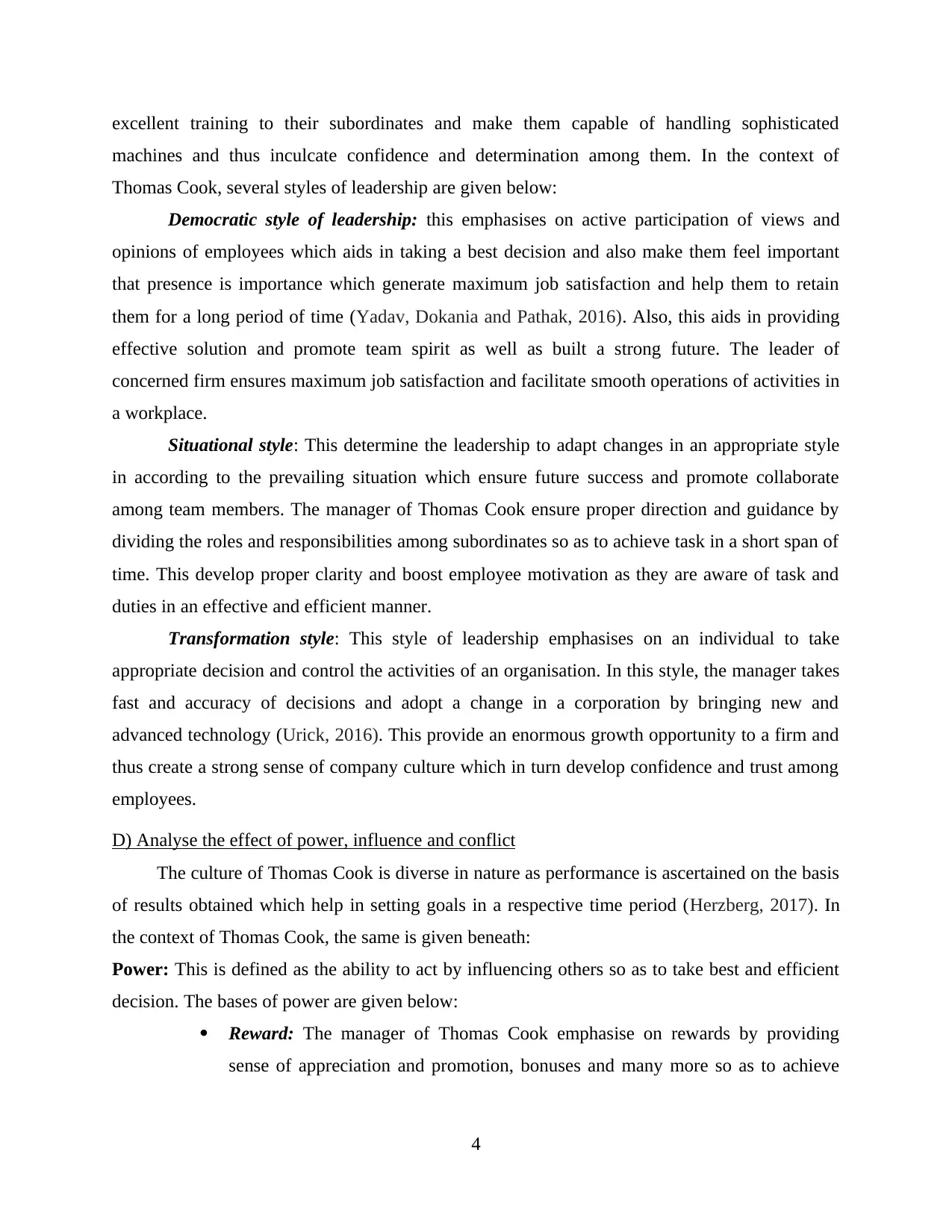
excellent training to their subordinates and make them capable of handling sophisticated
machines and thus inculcate confidence and determination among them. In the context of
Thomas Cook, several styles of leadership are given below:
Democratic style of leadership: this emphasises on active participation of views and
opinions of employees which aids in taking a best decision and also make them feel important
that presence is importance which generate maximum job satisfaction and help them to retain
them for a long period of time (Yadav, Dokania and Pathak, 2016). Also, this aids in providing
effective solution and promote team spirit as well as built a strong future. The leader of
concerned firm ensures maximum job satisfaction and facilitate smooth operations of activities in
a workplace.
Situational style: This determine the leadership to adapt changes in an appropriate style
in according to the prevailing situation which ensure future success and promote collaborate
among team members. The manager of Thomas Cook ensure proper direction and guidance by
dividing the roles and responsibilities among subordinates so as to achieve task in a short span of
time. This develop proper clarity and boost employee motivation as they are aware of task and
duties in an effective and efficient manner.
Transformation style: This style of leadership emphasises on an individual to take
appropriate decision and control the activities of an organisation. In this style, the manager takes
fast and accuracy of decisions and adopt a change in a corporation by bringing new and
advanced technology (Urick, 2016). This provide an enormous growth opportunity to a firm and
thus create a strong sense of company culture which in turn develop confidence and trust among
employees.
D) Analyse the effect of power, influence and conflict
The culture of Thomas Cook is diverse in nature as performance is ascertained on the basis
of results obtained which help in setting goals in a respective time period (Herzberg, 2017). In
the context of Thomas Cook, the same is given beneath:
Power: This is defined as the ability to act by influencing others so as to take best and efficient
decision. The bases of power are given below:
Reward: The manager of Thomas Cook emphasise on rewards by providing
sense of appreciation and promotion, bonuses and many more so as to achieve
4
machines and thus inculcate confidence and determination among them. In the context of
Thomas Cook, several styles of leadership are given below:
Democratic style of leadership: this emphasises on active participation of views and
opinions of employees which aids in taking a best decision and also make them feel important
that presence is importance which generate maximum job satisfaction and help them to retain
them for a long period of time (Yadav, Dokania and Pathak, 2016). Also, this aids in providing
effective solution and promote team spirit as well as built a strong future. The leader of
concerned firm ensures maximum job satisfaction and facilitate smooth operations of activities in
a workplace.
Situational style: This determine the leadership to adapt changes in an appropriate style
in according to the prevailing situation which ensure future success and promote collaborate
among team members. The manager of Thomas Cook ensure proper direction and guidance by
dividing the roles and responsibilities among subordinates so as to achieve task in a short span of
time. This develop proper clarity and boost employee motivation as they are aware of task and
duties in an effective and efficient manner.
Transformation style: This style of leadership emphasises on an individual to take
appropriate decision and control the activities of an organisation. In this style, the manager takes
fast and accuracy of decisions and adopt a change in a corporation by bringing new and
advanced technology (Urick, 2016). This provide an enormous growth opportunity to a firm and
thus create a strong sense of company culture which in turn develop confidence and trust among
employees.
D) Analyse the effect of power, influence and conflict
The culture of Thomas Cook is diverse in nature as performance is ascertained on the basis
of results obtained which help in setting goals in a respective time period (Herzberg, 2017). In
the context of Thomas Cook, the same is given beneath:
Power: This is defined as the ability to act by influencing others so as to take best and efficient
decision. The bases of power are given below:
Reward: The manager of Thomas Cook emphasise on rewards by providing
sense of appreciation and promotion, bonuses and many more so as to achieve
4
⊘ This is a preview!⊘
Do you want full access?
Subscribe today to unlock all pages.

Trusted by 1+ million students worldwide
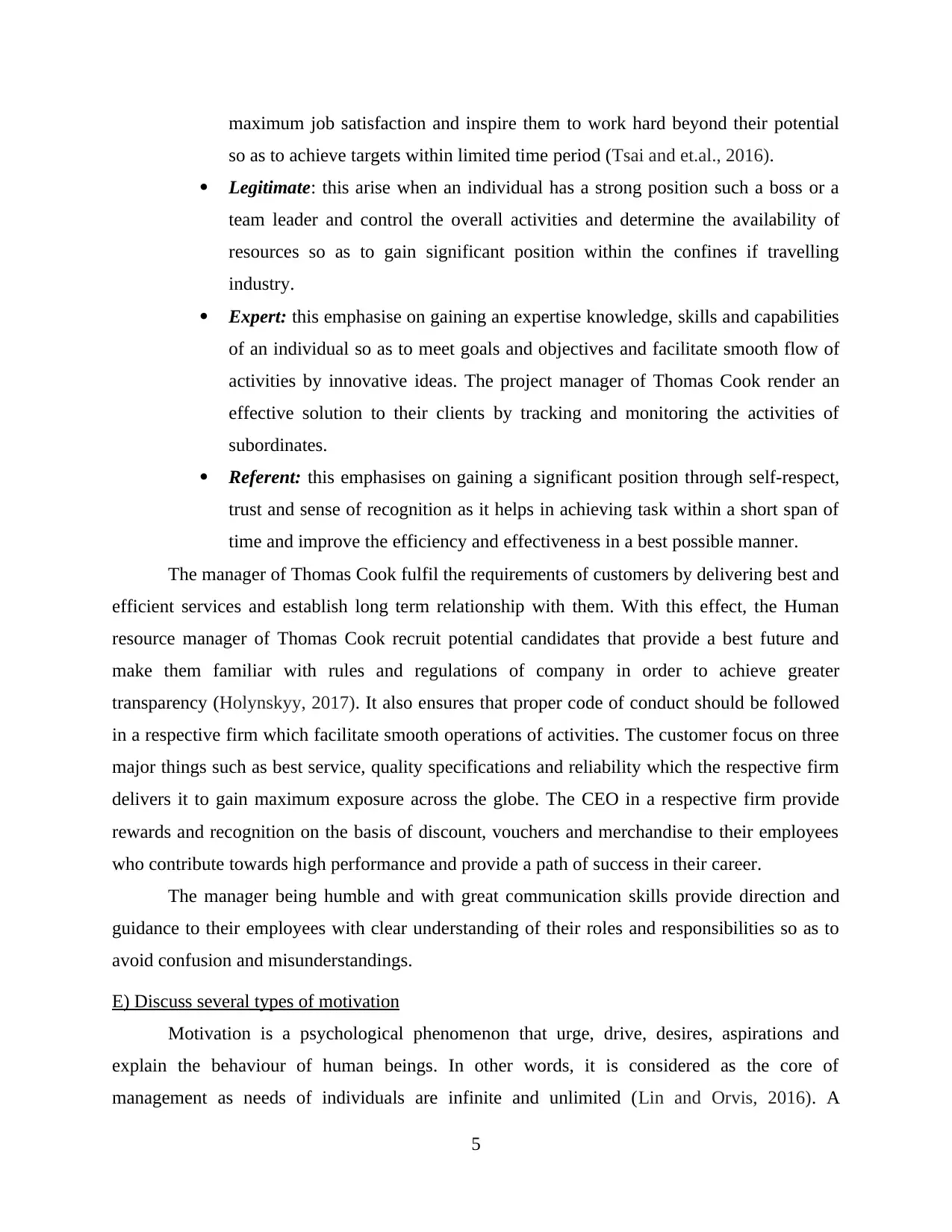
maximum job satisfaction and inspire them to work hard beyond their potential
so as to achieve targets within limited time period (Tsai and et.al., 2016).
Legitimate: this arise when an individual has a strong position such a boss or a
team leader and control the overall activities and determine the availability of
resources so as to gain significant position within the confines if travelling
industry.
Expert: this emphasise on gaining an expertise knowledge, skills and capabilities
of an individual so as to meet goals and objectives and facilitate smooth flow of
activities by innovative ideas. The project manager of Thomas Cook render an
effective solution to their clients by tracking and monitoring the activities of
subordinates.
Referent: this emphasises on gaining a significant position through self-respect,
trust and sense of recognition as it helps in achieving task within a short span of
time and improve the efficiency and effectiveness in a best possible manner.
The manager of Thomas Cook fulfil the requirements of customers by delivering best and
efficient services and establish long term relationship with them. With this effect, the Human
resource manager of Thomas Cook recruit potential candidates that provide a best future and
make them familiar with rules and regulations of company in order to achieve greater
transparency (Holynskyy, 2017). It also ensures that proper code of conduct should be followed
in a respective firm which facilitate smooth operations of activities. The customer focus on three
major things such as best service, quality specifications and reliability which the respective firm
delivers it to gain maximum exposure across the globe. The CEO in a respective firm provide
rewards and recognition on the basis of discount, vouchers and merchandise to their employees
who contribute towards high performance and provide a path of success in their career.
The manager being humble and with great communication skills provide direction and
guidance to their employees with clear understanding of their roles and responsibilities so as to
avoid confusion and misunderstandings.
E) Discuss several types of motivation
Motivation is a psychological phenomenon that urge, drive, desires, aspirations and
explain the behaviour of human beings. In other words, it is considered as the core of
management as needs of individuals are infinite and unlimited (Lin and Orvis, 2016). A
5
so as to achieve targets within limited time period (Tsai and et.al., 2016).
Legitimate: this arise when an individual has a strong position such a boss or a
team leader and control the overall activities and determine the availability of
resources so as to gain significant position within the confines if travelling
industry.
Expert: this emphasise on gaining an expertise knowledge, skills and capabilities
of an individual so as to meet goals and objectives and facilitate smooth flow of
activities by innovative ideas. The project manager of Thomas Cook render an
effective solution to their clients by tracking and monitoring the activities of
subordinates.
Referent: this emphasises on gaining a significant position through self-respect,
trust and sense of recognition as it helps in achieving task within a short span of
time and improve the efficiency and effectiveness in a best possible manner.
The manager of Thomas Cook fulfil the requirements of customers by delivering best and
efficient services and establish long term relationship with them. With this effect, the Human
resource manager of Thomas Cook recruit potential candidates that provide a best future and
make them familiar with rules and regulations of company in order to achieve greater
transparency (Holynskyy, 2017). It also ensures that proper code of conduct should be followed
in a respective firm which facilitate smooth operations of activities. The customer focus on three
major things such as best service, quality specifications and reliability which the respective firm
delivers it to gain maximum exposure across the globe. The CEO in a respective firm provide
rewards and recognition on the basis of discount, vouchers and merchandise to their employees
who contribute towards high performance and provide a path of success in their career.
The manager being humble and with great communication skills provide direction and
guidance to their employees with clear understanding of their roles and responsibilities so as to
avoid confusion and misunderstandings.
E) Discuss several types of motivation
Motivation is a psychological phenomenon that urge, drive, desires, aspirations and
explain the behaviour of human beings. In other words, it is considered as the core of
management as needs of individuals are infinite and unlimited (Lin and Orvis, 2016). A
5
Paraphrase This Document
Need a fresh take? Get an instant paraphrase of this document with our AI Paraphraser
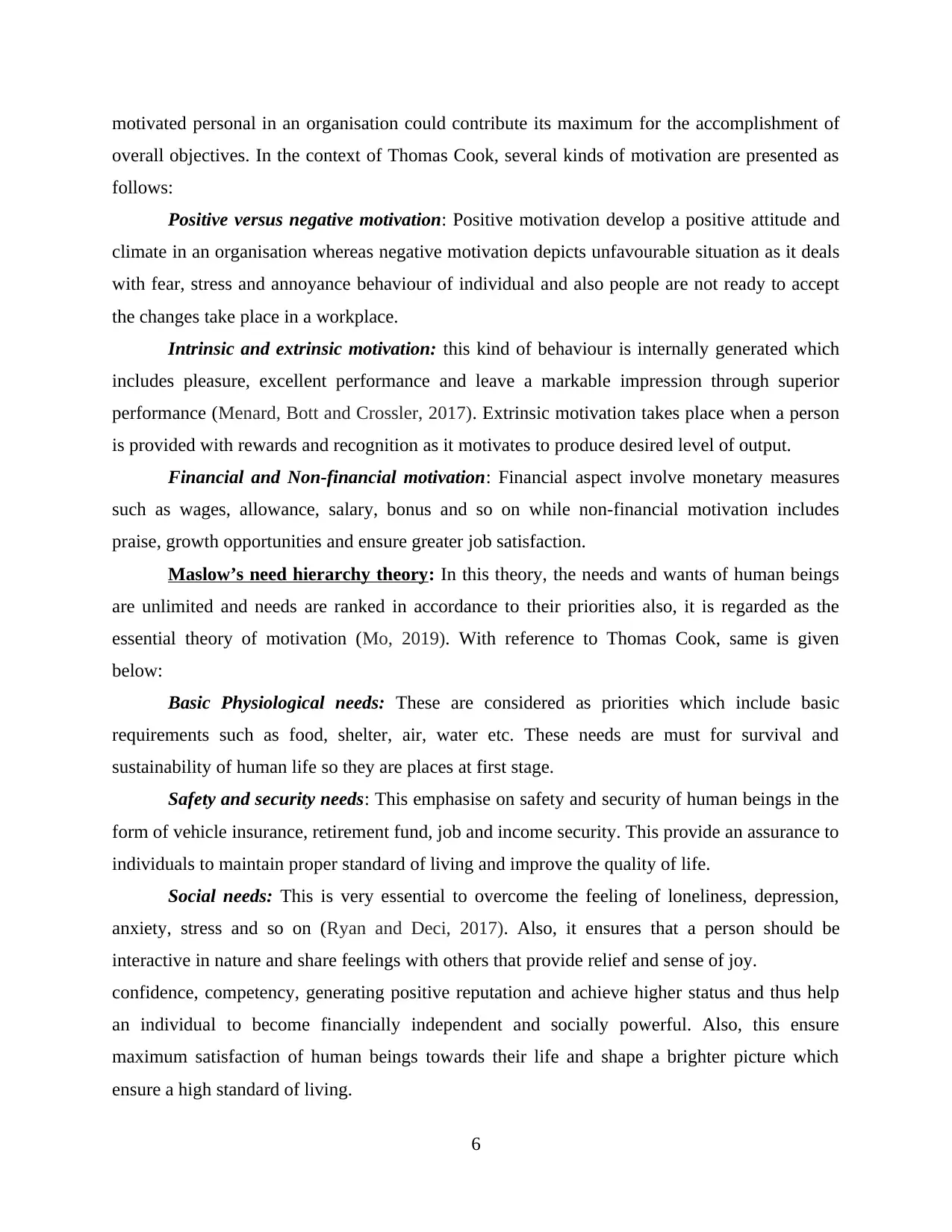
motivated personal in an organisation could contribute its maximum for the accomplishment of
overall objectives. In the context of Thomas Cook, several kinds of motivation are presented as
follows:
Positive versus negative motivation: Positive motivation develop a positive attitude and
climate in an organisation whereas negative motivation depicts unfavourable situation as it deals
with fear, stress and annoyance behaviour of individual and also people are not ready to accept
the changes take place in a workplace.
Intrinsic and extrinsic motivation: this kind of behaviour is internally generated which
includes pleasure, excellent performance and leave a markable impression through superior
performance (Menard, Bott and Crossler, 2017). Extrinsic motivation takes place when a person
is provided with rewards and recognition as it motivates to produce desired level of output.
Financial and Non-financial motivation: Financial aspect involve monetary measures
such as wages, allowance, salary, bonus and so on while non-financial motivation includes
praise, growth opportunities and ensure greater job satisfaction.
Maslow’s need hierarchy theory: In this theory, the needs and wants of human beings
are unlimited and needs are ranked in accordance to their priorities also, it is regarded as the
essential theory of motivation (Mo, 2019). With reference to Thomas Cook, same is given
below:
Basic Physiological needs: These are considered as priorities which include basic
requirements such as food, shelter, air, water etc. These needs are must for survival and
sustainability of human life so they are places at first stage.
Safety and security needs: This emphasise on safety and security of human beings in the
form of vehicle insurance, retirement fund, job and income security. This provide an assurance to
individuals to maintain proper standard of living and improve the quality of life.
Social needs: This is very essential to overcome the feeling of loneliness, depression,
anxiety, stress and so on (Ryan and Deci, 2017). Also, it ensures that a person should be
interactive in nature and share feelings with others that provide relief and sense of joy.
confidence, competency, generating positive reputation and achieve higher status and thus help
an individual to become financially independent and socially powerful. Also, this ensure
maximum satisfaction of human beings towards their life and shape a brighter picture which
ensure a high standard of living.
6
overall objectives. In the context of Thomas Cook, several kinds of motivation are presented as
follows:
Positive versus negative motivation: Positive motivation develop a positive attitude and
climate in an organisation whereas negative motivation depicts unfavourable situation as it deals
with fear, stress and annoyance behaviour of individual and also people are not ready to accept
the changes take place in a workplace.
Intrinsic and extrinsic motivation: this kind of behaviour is internally generated which
includes pleasure, excellent performance and leave a markable impression through superior
performance (Menard, Bott and Crossler, 2017). Extrinsic motivation takes place when a person
is provided with rewards and recognition as it motivates to produce desired level of output.
Financial and Non-financial motivation: Financial aspect involve monetary measures
such as wages, allowance, salary, bonus and so on while non-financial motivation includes
praise, growth opportunities and ensure greater job satisfaction.
Maslow’s need hierarchy theory: In this theory, the needs and wants of human beings
are unlimited and needs are ranked in accordance to their priorities also, it is regarded as the
essential theory of motivation (Mo, 2019). With reference to Thomas Cook, same is given
below:
Basic Physiological needs: These are considered as priorities which include basic
requirements such as food, shelter, air, water etc. These needs are must for survival and
sustainability of human life so they are places at first stage.
Safety and security needs: This emphasise on safety and security of human beings in the
form of vehicle insurance, retirement fund, job and income security. This provide an assurance to
individuals to maintain proper standard of living and improve the quality of life.
Social needs: This is very essential to overcome the feeling of loneliness, depression,
anxiety, stress and so on (Ryan and Deci, 2017). Also, it ensures that a person should be
interactive in nature and share feelings with others that provide relief and sense of joy.
confidence, competency, generating positive reputation and achieve higher status and thus help
an individual to become financially independent and socially powerful. Also, this ensure
maximum satisfaction of human beings towards their life and shape a brighter picture which
ensure a high standard of living.
6
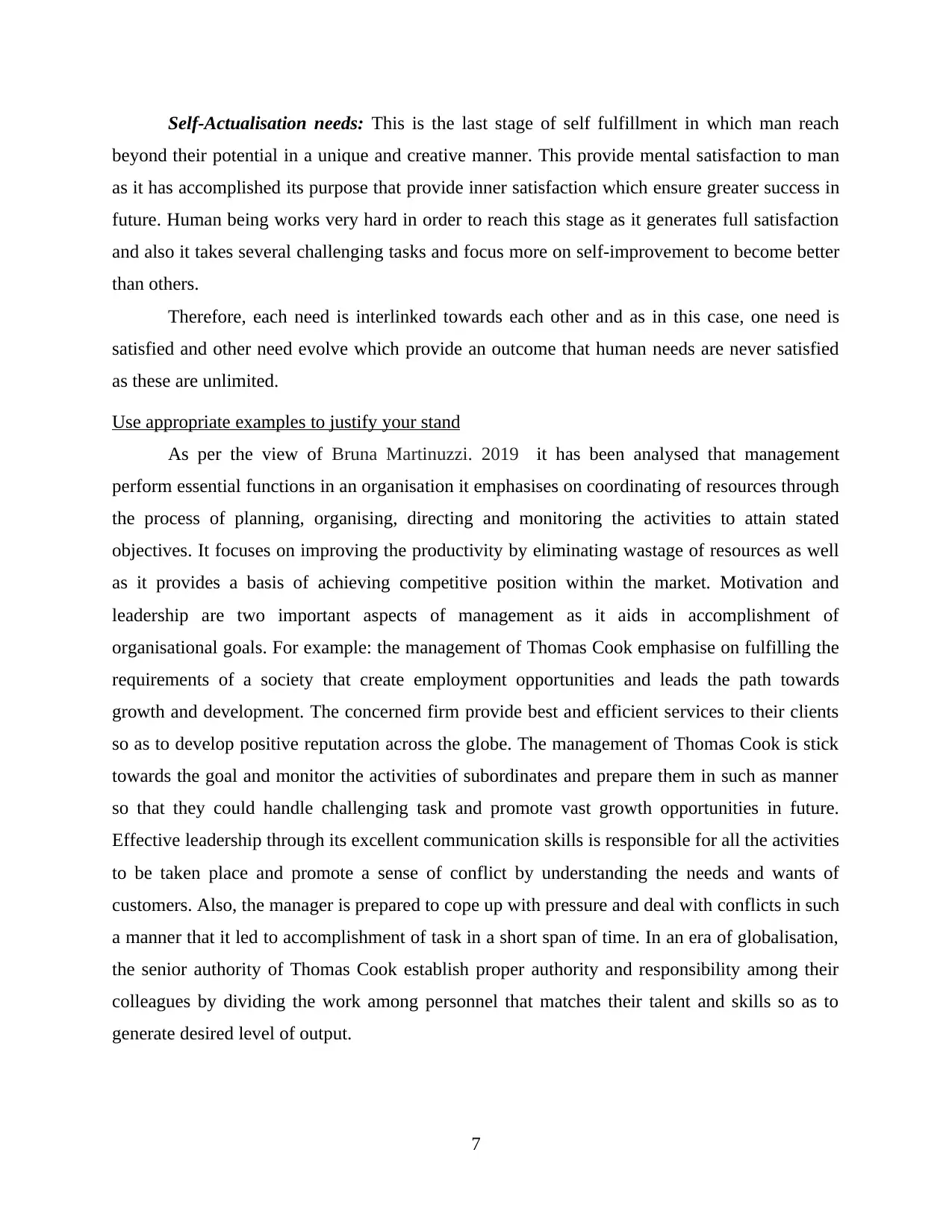
Self-Actualisation needs: This is the last stage of self fulfillment in which man reach
beyond their potential in a unique and creative manner. This provide mental satisfaction to man
as it has accomplished its purpose that provide inner satisfaction which ensure greater success in
future. Human being works very hard in order to reach this stage as it generates full satisfaction
and also it takes several challenging tasks and focus more on self-improvement to become better
than others.
Therefore, each need is interlinked towards each other and as in this case, one need is
satisfied and other need evolve which provide an outcome that human needs are never satisfied
as these are unlimited.
Use appropriate examples to justify your stand
As per the view of Bruna Martinuzzi. 2019 it has been analysed that management
perform essential functions in an organisation it emphasises on coordinating of resources through
the process of planning, organising, directing and monitoring the activities to attain stated
objectives. It focuses on improving the productivity by eliminating wastage of resources as well
as it provides a basis of achieving competitive position within the market. Motivation and
leadership are two important aspects of management as it aids in accomplishment of
organisational goals. For example: the management of Thomas Cook emphasise on fulfilling the
requirements of a society that create employment opportunities and leads the path towards
growth and development. The concerned firm provide best and efficient services to their clients
so as to develop positive reputation across the globe. The management of Thomas Cook is stick
towards the goal and monitor the activities of subordinates and prepare them in such as manner
so that they could handle challenging task and promote vast growth opportunities in future.
Effective leadership through its excellent communication skills is responsible for all the activities
to be taken place and promote a sense of conflict by understanding the needs and wants of
customers. Also, the manager is prepared to cope up with pressure and deal with conflicts in such
a manner that it led to accomplishment of task in a short span of time. In an era of globalisation,
the senior authority of Thomas Cook establish proper authority and responsibility among their
colleagues by dividing the work among personnel that matches their talent and skills so as to
generate desired level of output.
7
beyond their potential in a unique and creative manner. This provide mental satisfaction to man
as it has accomplished its purpose that provide inner satisfaction which ensure greater success in
future. Human being works very hard in order to reach this stage as it generates full satisfaction
and also it takes several challenging tasks and focus more on self-improvement to become better
than others.
Therefore, each need is interlinked towards each other and as in this case, one need is
satisfied and other need evolve which provide an outcome that human needs are never satisfied
as these are unlimited.
Use appropriate examples to justify your stand
As per the view of Bruna Martinuzzi. 2019 it has been analysed that management
perform essential functions in an organisation it emphasises on coordinating of resources through
the process of planning, organising, directing and monitoring the activities to attain stated
objectives. It focuses on improving the productivity by eliminating wastage of resources as well
as it provides a basis of achieving competitive position within the market. Motivation and
leadership are two important aspects of management as it aids in accomplishment of
organisational goals. For example: the management of Thomas Cook emphasise on fulfilling the
requirements of a society that create employment opportunities and leads the path towards
growth and development. The concerned firm provide best and efficient services to their clients
so as to develop positive reputation across the globe. The management of Thomas Cook is stick
towards the goal and monitor the activities of subordinates and prepare them in such as manner
so that they could handle challenging task and promote vast growth opportunities in future.
Effective leadership through its excellent communication skills is responsible for all the activities
to be taken place and promote a sense of conflict by understanding the needs and wants of
customers. Also, the manager is prepared to cope up with pressure and deal with conflicts in such
a manner that it led to accomplishment of task in a short span of time. In an era of globalisation,
the senior authority of Thomas Cook establish proper authority and responsibility among their
colleagues by dividing the work among personnel that matches their talent and skills so as to
generate desired level of output.
7
⊘ This is a preview!⊘
Do you want full access?
Subscribe today to unlock all pages.

Trusted by 1+ million students worldwide
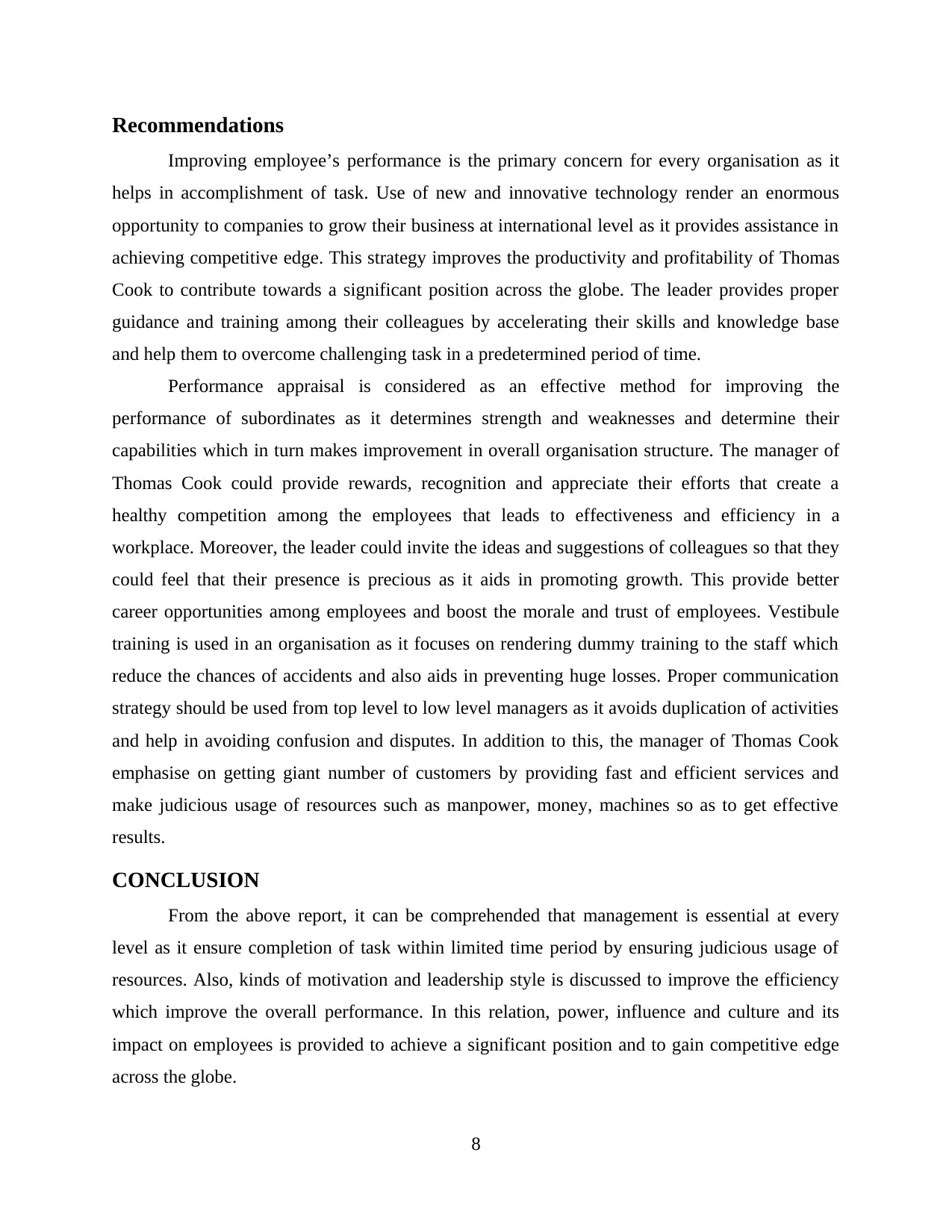
Recommendations
Improving employee’s performance is the primary concern for every organisation as it
helps in accomplishment of task. Use of new and innovative technology render an enormous
opportunity to companies to grow their business at international level as it provides assistance in
achieving competitive edge. This strategy improves the productivity and profitability of Thomas
Cook to contribute towards a significant position across the globe. The leader provides proper
guidance and training among their colleagues by accelerating their skills and knowledge base
and help them to overcome challenging task in a predetermined period of time.
Performance appraisal is considered as an effective method for improving the
performance of subordinates as it determines strength and weaknesses and determine their
capabilities which in turn makes improvement in overall organisation structure. The manager of
Thomas Cook could provide rewards, recognition and appreciate their efforts that create a
healthy competition among the employees that leads to effectiveness and efficiency in a
workplace. Moreover, the leader could invite the ideas and suggestions of colleagues so that they
could feel that their presence is precious as it aids in promoting growth. This provide better
career opportunities among employees and boost the morale and trust of employees. Vestibule
training is used in an organisation as it focuses on rendering dummy training to the staff which
reduce the chances of accidents and also aids in preventing huge losses. Proper communication
strategy should be used from top level to low level managers as it avoids duplication of activities
and help in avoiding confusion and disputes. In addition to this, the manager of Thomas Cook
emphasise on getting giant number of customers by providing fast and efficient services and
make judicious usage of resources such as manpower, money, machines so as to get effective
results.
CONCLUSION
From the above report, it can be comprehended that management is essential at every
level as it ensure completion of task within limited time period by ensuring judicious usage of
resources. Also, kinds of motivation and leadership style is discussed to improve the efficiency
which improve the overall performance. In this relation, power, influence and culture and its
impact on employees is provided to achieve a significant position and to gain competitive edge
across the globe.
8
Improving employee’s performance is the primary concern for every organisation as it
helps in accomplishment of task. Use of new and innovative technology render an enormous
opportunity to companies to grow their business at international level as it provides assistance in
achieving competitive edge. This strategy improves the productivity and profitability of Thomas
Cook to contribute towards a significant position across the globe. The leader provides proper
guidance and training among their colleagues by accelerating their skills and knowledge base
and help them to overcome challenging task in a predetermined period of time.
Performance appraisal is considered as an effective method for improving the
performance of subordinates as it determines strength and weaknesses and determine their
capabilities which in turn makes improvement in overall organisation structure. The manager of
Thomas Cook could provide rewards, recognition and appreciate their efforts that create a
healthy competition among the employees that leads to effectiveness and efficiency in a
workplace. Moreover, the leader could invite the ideas and suggestions of colleagues so that they
could feel that their presence is precious as it aids in promoting growth. This provide better
career opportunities among employees and boost the morale and trust of employees. Vestibule
training is used in an organisation as it focuses on rendering dummy training to the staff which
reduce the chances of accidents and also aids in preventing huge losses. Proper communication
strategy should be used from top level to low level managers as it avoids duplication of activities
and help in avoiding confusion and disputes. In addition to this, the manager of Thomas Cook
emphasise on getting giant number of customers by providing fast and efficient services and
make judicious usage of resources such as manpower, money, machines so as to get effective
results.
CONCLUSION
From the above report, it can be comprehended that management is essential at every
level as it ensure completion of task within limited time period by ensuring judicious usage of
resources. Also, kinds of motivation and leadership style is discussed to improve the efficiency
which improve the overall performance. In this relation, power, influence and culture and its
impact on employees is provided to achieve a significant position and to gain competitive edge
across the globe.
8
Paraphrase This Document
Need a fresh take? Get an instant paraphrase of this document with our AI Paraphraser
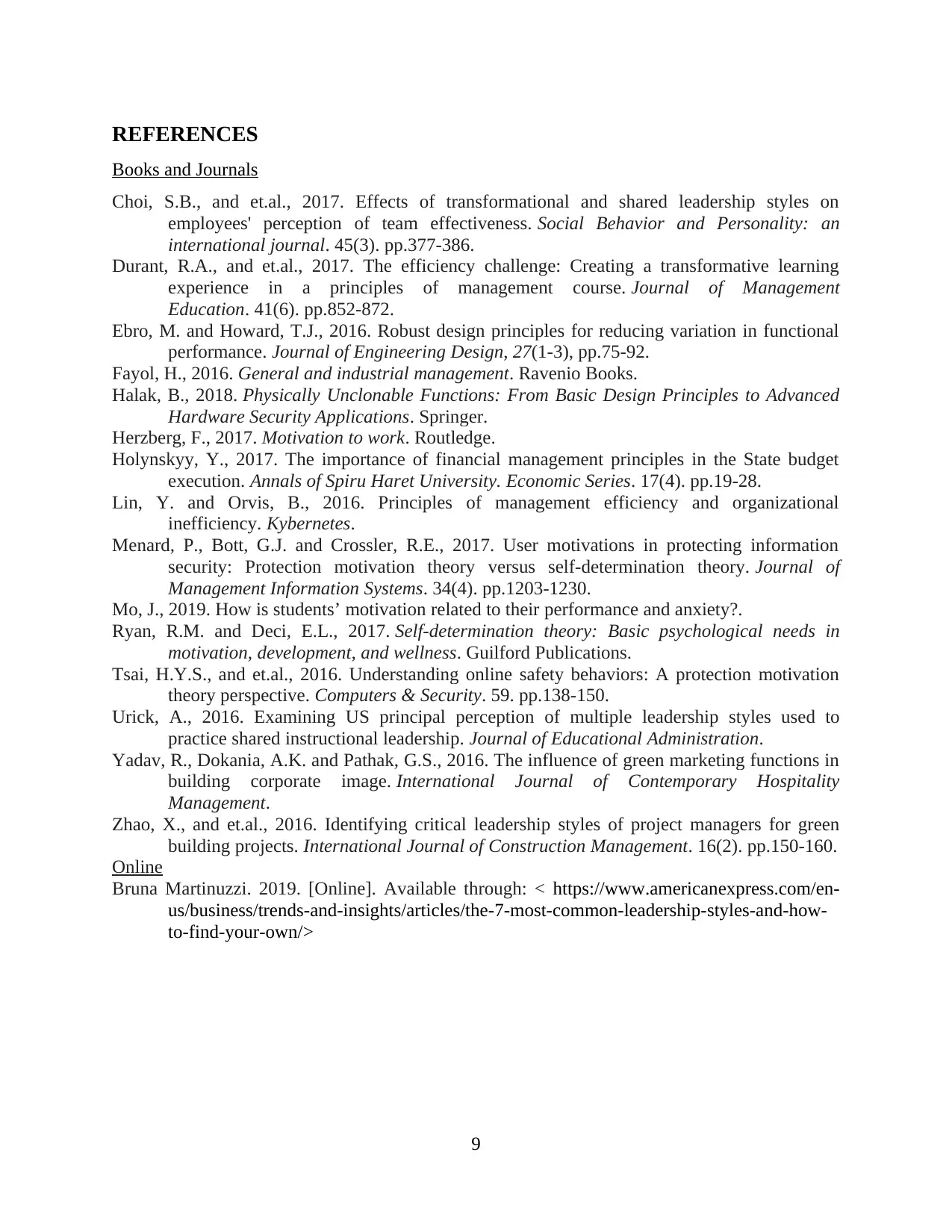
REFERENCES
Books and Journals
Choi, S.B., and et.al., 2017. Effects of transformational and shared leadership styles on
employees' perception of team effectiveness. Social Behavior and Personality: an
international journal. 45(3). pp.377-386.
Durant, R.A., and et.al., 2017. The efficiency challenge: Creating a transformative learning
experience in a principles of management course. Journal of Management
Education. 41(6). pp.852-872.
Ebro, M. and Howard, T.J., 2016. Robust design principles for reducing variation in functional
performance. Journal of Engineering Design, 27(1-3), pp.75-92.
Fayol, H., 2016. General and industrial management. Ravenio Books.
Halak, B., 2018. Physically Unclonable Functions: From Basic Design Principles to Advanced
Hardware Security Applications. Springer.
Herzberg, F., 2017. Motivation to work. Routledge.
Holynskyy, Y., 2017. The importance of financial management principles in the State budget
execution. Annals of Spiru Haret University. Economic Series. 17(4). pp.19-28.
Lin, Y. and Orvis, B., 2016. Principles of management efficiency and organizational
inefficiency. Kybernetes.
Menard, P., Bott, G.J. and Crossler, R.E., 2017. User motivations in protecting information
security: Protection motivation theory versus self-determination theory. Journal of
Management Information Systems. 34(4). pp.1203-1230.
Mo, J., 2019. How is students’ motivation related to their performance and anxiety?.
Ryan, R.M. and Deci, E.L., 2017. Self-determination theory: Basic psychological needs in
motivation, development, and wellness. Guilford Publications.
Tsai, H.Y.S., and et.al., 2016. Understanding online safety behaviors: A protection motivation
theory perspective. Computers & Security. 59. pp.138-150.
Urick, A., 2016. Examining US principal perception of multiple leadership styles used to
practice shared instructional leadership. Journal of Educational Administration.
Yadav, R., Dokania, A.K. and Pathak, G.S., 2016. The influence of green marketing functions in
building corporate image. International Journal of Contemporary Hospitality
Management.
Zhao, X., and et.al., 2016. Identifying critical leadership styles of project managers for green
building projects. International Journal of Construction Management. 16(2). pp.150-160.
Online
Bruna Martinuzzi. 2019. [Online]. Available through: < https://www.americanexpress.com/en-
us/business/trends-and-insights/articles/the-7-most-common-leadership-styles-and-how-
to-find-your-own/>
9
Books and Journals
Choi, S.B., and et.al., 2017. Effects of transformational and shared leadership styles on
employees' perception of team effectiveness. Social Behavior and Personality: an
international journal. 45(3). pp.377-386.
Durant, R.A., and et.al., 2017. The efficiency challenge: Creating a transformative learning
experience in a principles of management course. Journal of Management
Education. 41(6). pp.852-872.
Ebro, M. and Howard, T.J., 2016. Robust design principles for reducing variation in functional
performance. Journal of Engineering Design, 27(1-3), pp.75-92.
Fayol, H., 2016. General and industrial management. Ravenio Books.
Halak, B., 2018. Physically Unclonable Functions: From Basic Design Principles to Advanced
Hardware Security Applications. Springer.
Herzberg, F., 2017. Motivation to work. Routledge.
Holynskyy, Y., 2017. The importance of financial management principles in the State budget
execution. Annals of Spiru Haret University. Economic Series. 17(4). pp.19-28.
Lin, Y. and Orvis, B., 2016. Principles of management efficiency and organizational
inefficiency. Kybernetes.
Menard, P., Bott, G.J. and Crossler, R.E., 2017. User motivations in protecting information
security: Protection motivation theory versus self-determination theory. Journal of
Management Information Systems. 34(4). pp.1203-1230.
Mo, J., 2019. How is students’ motivation related to their performance and anxiety?.
Ryan, R.M. and Deci, E.L., 2017. Self-determination theory: Basic psychological needs in
motivation, development, and wellness. Guilford Publications.
Tsai, H.Y.S., and et.al., 2016. Understanding online safety behaviors: A protection motivation
theory perspective. Computers & Security. 59. pp.138-150.
Urick, A., 2016. Examining US principal perception of multiple leadership styles used to
practice shared instructional leadership. Journal of Educational Administration.
Yadav, R., Dokania, A.K. and Pathak, G.S., 2016. The influence of green marketing functions in
building corporate image. International Journal of Contemporary Hospitality
Management.
Zhao, X., and et.al., 2016. Identifying critical leadership styles of project managers for green
building projects. International Journal of Construction Management. 16(2). pp.150-160.
Online
Bruna Martinuzzi. 2019. [Online]. Available through: < https://www.americanexpress.com/en-
us/business/trends-and-insights/articles/the-7-most-common-leadership-styles-and-how-
to-find-your-own/>
9
1 out of 11
Related Documents
Your All-in-One AI-Powered Toolkit for Academic Success.
+13062052269
info@desklib.com
Available 24*7 on WhatsApp / Email
![[object Object]](/_next/static/media/star-bottom.7253800d.svg)
Unlock your academic potential
Copyright © 2020–2025 A2Z Services. All Rights Reserved. Developed and managed by ZUCOL.





